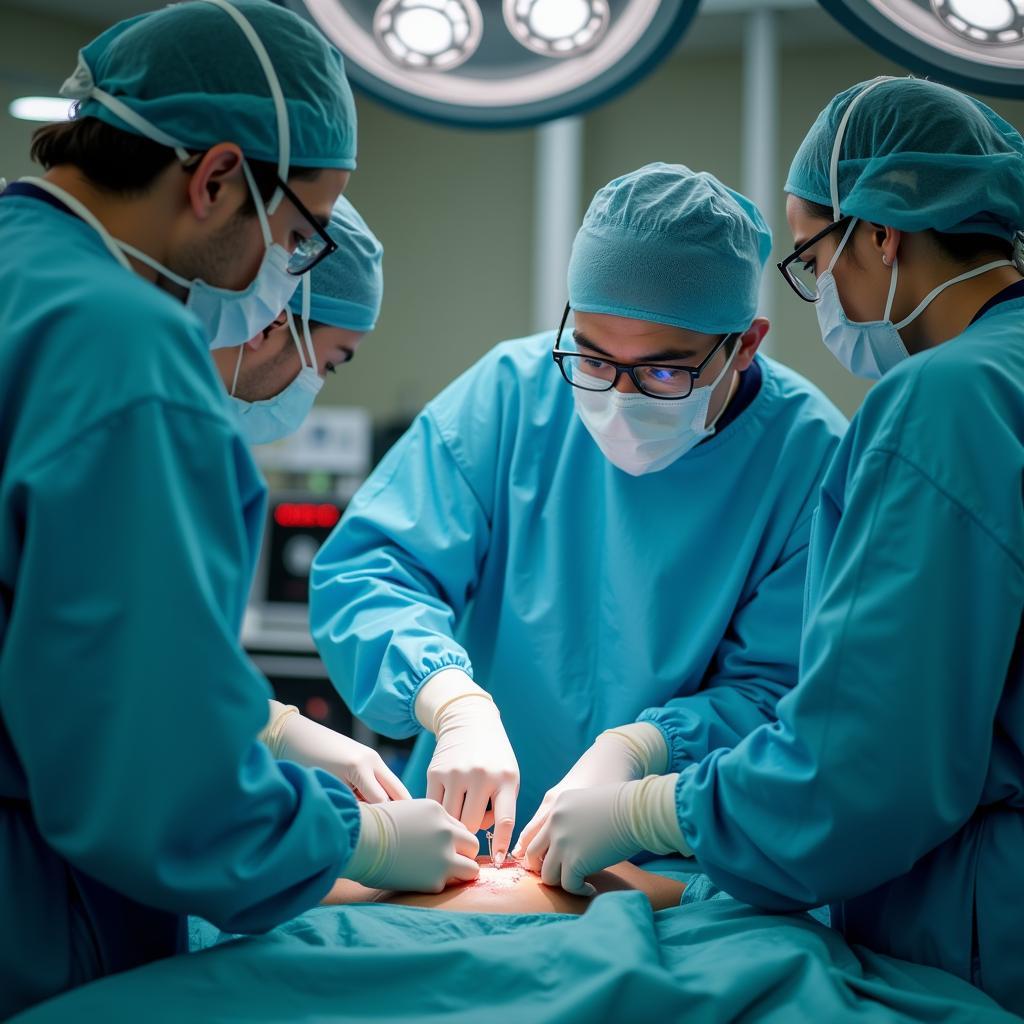Hospitals, often seen as monolithic structures dedicated to healthcare, are actually intricate ecosystems comprising diverse areas, each playing a crucial role in patient care and well-being. From the bustling emergency room to the serene gardens, understanding the functions of these areas can demystify the hospital experience for patients and their families.
Essential Areas for Immediate Care
The most well-known area in a hospital is arguably the Emergency Room (ER). Staffed with specialized medical professionals trained to handle critical situations, this area serves as the first point of contact for patients requiring immediate medical attention. Conditions like heart attacks, strokes, and severe injuries are all treated within this high-pressure, fast-paced environment.
 Emergency Room Treatment in Progress
Emergency Room Treatment in Progress
Closely linked to the ER is the Intensive Care Unit (ICU), reserved for patients requiring constant monitoring and advanced life support. Specialized nurses and physicians with expertise in critical care manage ventilators, intravenous medications, and other advanced technologies to stabilize critically ill patients.
Areas Dedicated to Surgical Procedures
 Surgical Team in the Operating Room
Surgical Team in the Operating Room
Surgical areas are another critical component of a hospital. Operating rooms, equipped with sophisticated surgical instruments and technology, are where skilled surgeons perform a wide range of procedures, from routine surgeries like appendectomies to complex organ transplants.
Adjacent to the operating rooms are post-anesthesia care units (PACUs), where patients recover immediately after surgery under the watchful eyes of nurses trained to manage post-operative pain and complications.
Specialized Departments for Targeted Care
Beyond the emergency and surgical areas, hospitals house a wide array of specialized departments catering to specific medical needs. The cardiology department focuses on diagnosing and treating heart conditions, employing technologies like EKGs, echocardiograms, and cardiac catheterization. The oncology department provides comprehensive cancer care, including chemotherapy, radiation therapy, and supportive care.
 Patient Recovering in a Hospital Room
Patient Recovering in a Hospital Room
Other specialized departments include:
- Neurology: Focusing on the brain, spinal cord, and nervous system.
- Gastroenterology: Addressing digestive system disorders.
- Pulmonology: Dedicated to lung health and respiratory illnesses.
- Nephrology: Specializing in kidney diseases and dialysis.
- Endocrinology: Managing hormonal imbalances and disorders.
Diagnostic and Imaging Areas
Accurate diagnosis is crucial for effective treatment, and hospitals have dedicated areas for various diagnostic tests. The radiology department utilizes advanced imaging technologies like X-rays, CT scans, and MRIs to visualize internal structures and identify abnormalities. The pathology lab analyzes tissue samples and biopsies to diagnose diseases at the cellular level.
Supporting a Comfortable and Healing Environment
While the medical areas are crucial, hospitals also prioritize patient comfort and well-being. Comfortable patient rooms, often equipped with adjustable beds, televisions, and private bathrooms, provide a space for rest and recovery.
Hospitals often feature amenities like:
- Cafeterias and gift shops: Offering convenience for patients and visitors.
- Pharmacies: Dispensing medications and providing pharmaceutical advice.
- Chapels or meditation rooms: Catering to spiritual needs and offering solace.
- Gardens and outdoor spaces: Providing a tranquil escape and promoting healing.
Conclusion
Understanding the different Areas In The Hospital can empower patients to navigate their healthcare journey with greater confidence. From the critical care units to the serene gardens, each area plays a vital role in providing comprehensive and compassionate care. By working together, these diverse areas contribute to a healing environment where patients can focus on recovery and well-being.
FAQs about Hospital Areas
1. What is the difference between the ER and the ICU?
The ER handles immediate medical emergencies, while the ICU provides continuous care for critically ill patients.
2. What happens in a post-anesthesia care unit (PACU)?
Patients recover from anesthesia and surgery in the PACU, with nurses monitoring their vital signs and managing pain.
3. What types of diagnostic tests are performed in a hospital?
Hospitals offer a wide range of diagnostic tests, including X-rays, CT scans, MRIs, blood tests, and biopsies.
4. Do hospitals have amenities for visitors?
Yes, most hospitals have cafeterias, gift shops, and waiting areas for visitors.
5. Are there areas for spiritual and emotional support?
Many hospitals offer chapels, meditation rooms, or access to chaplains for spiritual and emotional support.
Need assistance? Contact us at Phone Number: 02437655121, Email: [email protected]. You can also visit us at 298 Cau Dien Street, Minh Khai Ward, Bac Tu Liem District, Hanoi, Vietnam. Our dedicated team is available 24/7 to assist you.